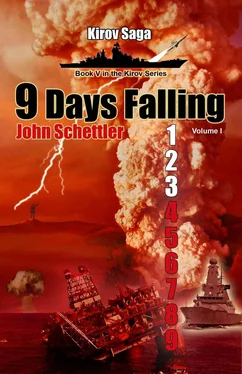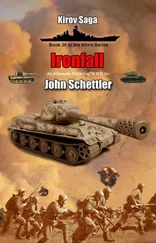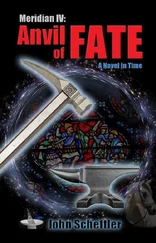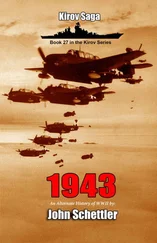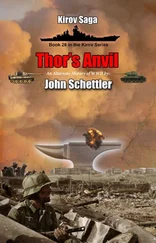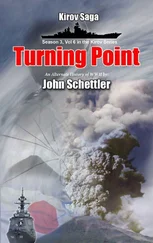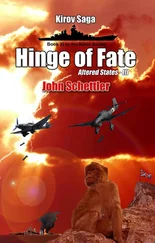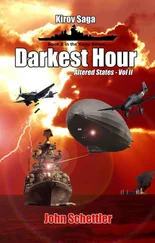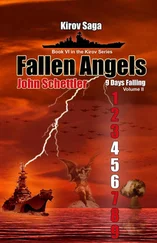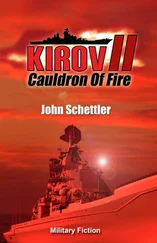By the time the strike wave was in close enough to launch, there were seven of twelve strike planes left. They had endured what the Japanese had faced, pressing on in the heat of the intense engagement, watching their buddies wheel in desperate attempts to evade the lethal SAMs, hearing their last words as they shouted and cursed the enemy they were facing. But seven got through to fire, and within seconds the sky was scored by the thin fuming rocket trails of twenty-eight Harpoons .
Fired at altitude like this, the missiles quickly descended to the deck. They weren’t fast at 860kph, nor were they particularly stealthy. But they were dogged, low flying lances that would be difficult to track and kill. The S-400 and S-300 systems were not going to be agile enough to get at them down on the deck. If a missile got through it would hit with a 500 pound warhead, nowhere near the wallop of the heavier Russian missiles, but more than enough to damage or disable a modern ship.
Aboard Kirov Rodenko saw the incoming barrage and informed Karpov. The ship and crew were ready at air defense action stations and within seconds Kirov’s medium range system dubbed the SA-N-92 by NATO was firing. The crab like Kashtan CIWS and 30mm chain guns were also armed and ready.
Two Udaloy class destroyers were in the first defensive screen, Marshal Shaposhnikov and Admiral Vinogradov. Once called Russia’s answer to the US Arleigh Burke class destroyer, they were in no way worthy of that claim. These were Udaloy I class ships, optimized for ASW duty, though they did carry both the SA-N-9 Gauntlet system, the earlier version of the same weapon Kirov was firing. Together they lit off a barrage with everything they had, eight missiles each. Kirov was the heart of the medium range defense, however with 128 upgraded missiles. It had more raw firepower than all four of the Udaloy destroyers in escort, and then some, but the destroyer Captains knew they were the screen and weren’t going to just sit there waiting for the American missiles to arrive. The barrage was thick enough to thin the soup a bit and when the Harpoons began their terminal approach to the fleet, there were eighteen left.
“Switching to Kashtan system at ten kilometers,” said Samsonov as Karpov looked on. There was much more tension in the room now. Those last mass attacks by the Japanese had raised more than a few hairs on the back of the crew’s necks, but this was something altogether different. The missiles were three to four times faster than the planes they had faced, and they were locking on with active radar. The electronics were so good the Russian jammers had no appreciable effect on the Harpoons . We’ve got range, mass, speed, thought Karpov, but they’ve got top notch electronics. We’ll see which side prevails.
Out in the screen brave Shaposhnikov fired its own CADS-N-1 Kashtans , missiles streaking away and skipping down towards the sea as they acquired the Harpoons . The cruiser Varyag got into it with a salvo of OSA-M missiles as well, and the skies above the turbulent sea were soon a spaghetti of missile wakes as they danced away to find targets—and find them they did. Eleven more Harpoons were swatted down by the close in missile defense barrage, and now the mini-guns were spitting fire and steel at the oncoming survivors, their hot barrels spinning furiously as the 9000 round magazine fed them shells. They got four more harpoons, but the final three were going to cross the finish line and find targets.
Admiral Vinogradov was hit first on her aft quarter and then on the number two deck gun when one of the Harpoons executed a popup maneuver and slammed the forward deck. The one two punch wracked the ship from bow to stern, and it was soon enveloped in thick black smoke. The last Harpoon was heading for Kirov , but in the heat of the action the Varyag had put on thirty knots and moved out off the big battlecruiser’s starboard side. Now her Captain Myshelev executed a high speed turn and drove his ship right into the path of the oncoming missile, heroically sacrificing his cruiser to protect the fleet flagship.
The bridge crew were awed by the maneuver, elated at first until they saw the explosion on the cruiser’s bow. Had the ship been quicker the missile would have struck her loaded missile tubes, arrayed in four sets of two on each side of the ship. As it was, the Harpoon struck the hull above the water line and blew right through the narrow angled bow.
Karpov grimaced when he saw the hit, though he knew the missile had not struck a vital spot. There would be a fire, casualties, but the ship would survive. He was soon on the radio to assess the situation.
“Falling on your sword, Myshelev?”
“Someone had to take the hit,” Myshelev’s gritty voice came back. He was a career officer that Karpov knew and respected, heavy set, gruff, and a hard taskmaster at sea. “Don’t worry, we’ll have the damage controlled in fifteen minutes. Most of the explosive force went right through the bow! We’ve got a broken nose to go with the one I already have, but we got lucky today.”
“We’ll toast you at officer’s mess,” said Karpov. Then his voice lowered to a more serious tone. “No more heroics, my friend. I need your Vulkans . Can you execute Long Arm?”
“Ready and able, Captain. Just say when.”
Karpov smiled. He had no idea what was happening with his submarine bastion. The boats had all gone silent after their initial barrage. They had orders to sprint to a new location, but he knew that American subs were out there as well, and the hunt was on. Fleet HQ Fokino had messaged him to indicate a second squadron of bombers was on the way, compliments of Admiral Leonid Volsky, but Karpov looked at his watch, knowing it could be another forty five minutes before the bombers were in position.
“What’s happening on our other flank, Rodenko?”
“Two squadrons off the American carrier are mixing it up with Kuznetzov’s fighter screen, sir. The fighting is intense! We’ve lost eight Mig-29s, but we hurt them as well. If anything gets through, they could be in firing position in twenty minutes.”
“Then we fire first,” Karpov said firmly. “How far away is that American carrier?”
“I’m reading its position at about 512 kilometers from the satellite data link, sir.”
Karpov turned to the communications officer. “Mister Nikolin, signal fleet message ‘Long Arm One.’ Execute at zero 10:40.”
“Aye, sir. Messaging all fleet units.”
He really only had to message two ships, Varyag and Kuznetsov farther north. They were the only fleet assets with the reach to fire and hurt the enemy now at this range. The carrier was packing twelve P-700 Granit Shipwreck missiles with a range of 625 kilometers. Varyag had the last of the P-1000 Vulkans , the only ones remaining in service on a surface ship now, sixteen big missiles that could reach out 700 kilometers.
The Russians had parried the American left thrust over Hokkaido, largely through the effectiveness and range of their long range SAMs. Now Kuznetsov’s fighters were embroiled in the fight, a strong shield holding off the other two American squadrons. Karpov knew the two groups had planned to time their strike together, but the attack had come unhinged, like a fighter who had tried to follow that left with a big right hand, but it was blocked. It was time to counterpunch.
The minutes ticked away. They watched Varyag bravely turn and point her crumpled bow at the distant horizon where the enemy waited. Then the missiles began to fly, long white javelins launching from angled firing tubes on either side of the cruiser. They fired in pairs, two at a time, their wings deploying after ejection and engines roaring with anger as they sped away. Developed in the late 1980s, little was known about the Vulkan for many years. In fact, NATO was not even aware that it had secretly been deployed on Russian surface ships. Now it made its debut in combat for the very first time before slipping into the mists of obsolescence, the last of the Mohicans.
Читать дальше
